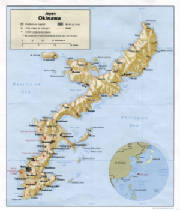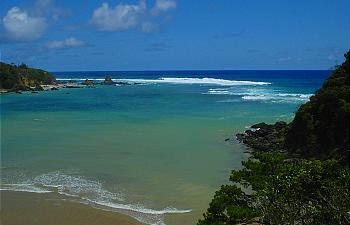|
|
 |
|
Introduction
|
 |
|
| Click picture to view |

|
| (Map) |
The Okinawa prefecture is located in the East China Sea,
southwest of mainland Japan (Background). This prefecture is made up of 161 islands of which only 44 of them are inhabited
(Background). "The islands are divided into three groups: the Okinawa island group, the Miyako island group, and the
Yaeyama island group." Of these three groups, Okinawa is the largest (Outline).
Ideally located between Kyushu, Japan's third largest island,
and Taiwan, puts Okinawa within a 1,500 km radius to major Asian cities. These cities included Taipei, Shanghai,
Hong Kong, Seoul, Manila and Tokyo. They influenced and helped shaped Okinawa one way or another. Okinawa's location
allowed them to "engage in prosperous overseas trade." Okinawa developed their unique cultural characteristics
through overseas trade as you will see displayed in their textiles, performing arts and food, and customs (Outline).
The Okinawa prefecture is comprised mostly
of coral rock. The rainwater filtered through the coral, which created many caves around the islands (Okinawa).
Okinawa is a long, narrow, irregularly shaped island of volcanic origin with coral formations in the southern part. The northern
part is mountainous. The islands are found in the same latitude zone as places such as Hawaii, Florida and the Bahamas,
thereby creating a subtropical climate. The average temperature is about 23 degrees C, never dropping below 10 degrees
C (Background). It has been said that the most beautiful beaches in all of Japan are found in Okinawa. The ideal
temperatures, beautiful beaches and the coral reefs provide an abundance of marine wildlife (Okinawa). Although the
Okinawans enjoy warm temperatures, they endure regular rainfall. This subtropical climate keep the islands lush
and green throughout the year, however, typhoons and monsoon rains are a common occurrence during the late summer and early
fall months (Background).
|
 |
|
| Click picture to view |

|
| (Picture) |
The islands that make up Okinawa
Prefecture are also known as Ryukyu Islands. Naha is the capital of Okinawa as well as Ryukyu's largest city.
Their chief agricultural products are sugarcane, sweet potatoes, pineapple and rice. Fishing is also important to the
economy. Most of Okinawa's export is sugar and canned pineapple (Ryukyu). Today one of the most important sources
of revenue come from tourism, the second, from U.S Military Bases in Okinawa (About). Nevertheless Okinawa is rich
in culture and heritage.
Whether one travels to northern, central or southern
Okinawa, there is an abundance of historical sites. The Okinawa Prefectural Museum, The Shuri Castle, The Cornerstone
of Peace, Zakimi Castle, or the statue of Kyuzo Toyama are just a few sites one might visit. So unique is their
rituals and beliefs, ceremonies and festivals, their language, music, and dance. Although, one does not need to
venture to Okinawa to experience their uniqueness, as Hawaii is their back yard. It has been approximately 104
years since the first Okinawan immigrants arrived in Hawaii. Since then they have infused their culture and heritage
into Hawaii's melting pot of multi culture creating an unparalleled combination. Read on and see the beauty that lies
within Okinawa and its' people.
|
 |
|
|
 |
|
|
|
|
|
|
 |

